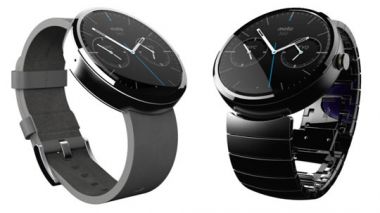Samsung Gear S vs Moto 360 specs: Traditional vs futuristic, which one will stand the test of time?

The Samsung Gear S and the Moto 360 are very different from one another. The design and the build and everything inside are just too distinct. Moto 360 is said to be a particular knockout in the smartwatch ground. Gear S will be out in 2015 and many can't wait to get it around their wrists. With Moto 360's impressive background and Gear S's promising feat, a specs showdown between the two new wearables is imposed to determine which one is really the one to watch.

The smartwatches are poles apart when it comes to appearance. The Samsung Gear S looks a bit too ultramodern as far as custom is concerned. Its futuristic look has been achieved with a curved rectangular glass watch face and mostly plastic backside. Meanwhile, the Moto 360 does not stray from the traditional. It sticks with the classic in resembling the usual flat and round timepieces without showing off all the new-fangled features infused in it. It's also made of stainless steel, which makes it very sleek. Users who like it subtle must undoubtedly go for the latter. Those who are audacious enough to parade a contemporary-looking wearable, the former will be the best way to go.
Surprisingly, their thinness is not too extreme. The Gear S is at 12.5 mm. The Moto 360's 11.5 mm is very comparative. Despite the different shapes, the two share proportional screen sizes, albeit with very far-off resolutions. The Gear S sports a 2-inch Super AMOLED display while the Moto 360 has a 1.56-inch IPS display. It is important to note here that although the Motorola wearable's face is round, the screen display is not. There is a tiny black sliver at the bottom part of the display. Although it seems to be too small of an issue, this may be a total game changer for some. Predictably, Gear S hitches the win in this area. With 480 x 360 screen resolution delivering a 300 ppi pixel density, the Gear S is much more capable of showing sharper and crisper info than the Moto 360's 320 x 290 and 205 ppi pixel density.
Now, on with the features. The wearables house 4 GB of RAM, so there's no issue with that. Also, both are water resistant, meaning users can submerge them on a meter-deep of freshwater for 30 minutes and the wearables will only come out as functional as ever. For voice control, the Moto 360's Google Now integration is apparently more extensive than the Gear S's S Voice. The Gear S however, bounces back with its phone call support. Thanks to the Tizen operating system running on the wearable and a speaker inbuilt, calling is made possible. Unfortunately, the Moto 360, which runs Android Wear, has not been modified for the task. The operating systems inside the two is also the very reason the Moto 360 can be synced to all Android devices running Android 4.3 and above and the basis for the Gear S's sole connectivity with the Galaxy handsets.
The Gear S leaves the Moto 360 behind as it is the smartwatch in this face-off that was shored up with a QWERTY keyboard integration, GPS and third-party app support. Both though, as expected, sport a heart-rate sensor.
Moto 360 is being attached with a battery drainage issue. Although the makers advertise it to run for a day, it is still not enough to match the Gear S's guarantee of a 2-day usage. Users can charge the Moto 360 every night wirelessly while the Gear S requires a cradle that snaps in its backside to be filled up.
The Moto 360 costs about $250. Users have to wait for the arrival of the Gear S to get a good idea of its price tag.











